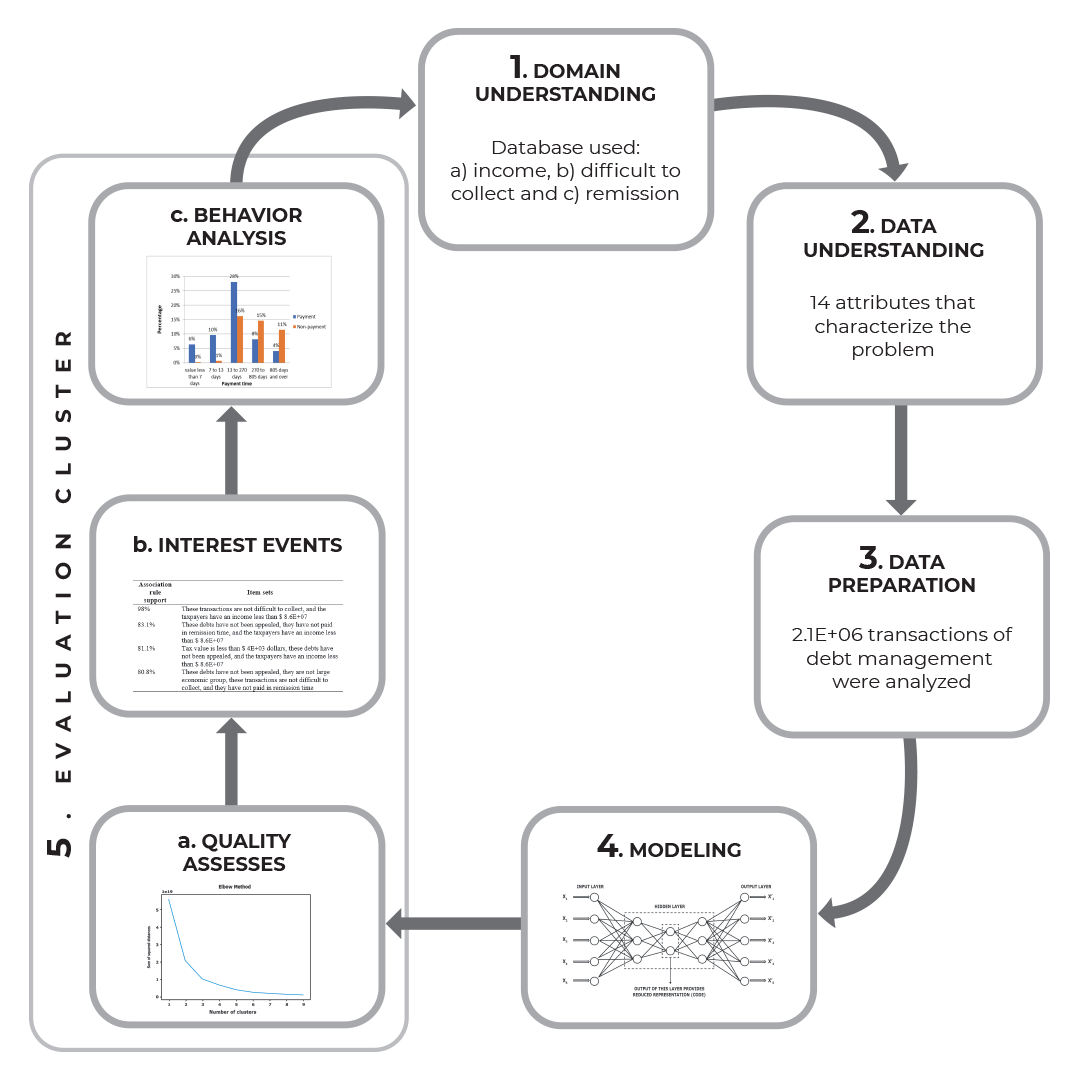Detección de Comportamientos Atípicos de Contribuyentes con Riesgo de no Pago en una Administración Tributaria, Un Marco de Trabajo de Minería de Datos
##plugins.themes.bootstrap3.article.main##
Resumen
Uno de los principales procesos en la administración tributarias es la gestión de cobranza. El objetivo de este proceso, entre otros, es la recuperación de los recursos económicos que han sido declarados por los contribuyentes. Debido a las limitaciones de las administraciones tributarias, tales como: personal, herramientas, tiempo, etc., las administraciones tributarias buscan la recuperación de las deudas en las etapas tempranas de control, donde el costo de recaudación es menor que en las etapas posteriores. Para optimizar el proceso de gestión de cobranza y contribuir a la toma de decisiones, este trabajo propone un marco de trabajo basado en aprendizaje profundo para detectar comportamientos atípicos de contribuyentes con alta probabilidad de no pago. Grupos de comportamiento normal y atípico fueron también analizados para encontrar eventos de interés usando reglas de asociación.
Descargas
Descargas
Detalles del artículo
Citas
Aggarwal, C. (2017). Outlier Analysis. Cham: Springer Nature. https://doi.org/10.1007/978-3-319-47578-3
Alink, V. (2000). Handbook for Tax Administrations Organizational structure and management of Tax Administration. The Netherlands: CIAT. https://www.ciat.org/Biblioteca/DocumentosTecnicos/Ingles/2000_handbook_for_ta_netherlands_ciat.pdf
Chapman, P., Clinton, J., Kerber, R., Khabaza, T., Reinartz, T., Shearer, C., & Wirth, R. (2000). CRISP-DM 1.0. USA: CRISP-DM consortium. https://www.kde.cs.uni-kassel.de/wp-content/uploads/lehre/ws2012-13/kdd/files/CRISPWP-0800.pdf
Chen, C., Wang, Y., Hu, W., & Zheng, Z. (2020). Robust multi-view k-means clustering with outlier removal. Knowledge-Based Systems. 210(2020), 1-12. https://doi.org/10.1016/j.knosys.2020.106518
Domingues, R., Filippone, M., & Michiar, P. (2018). A comparative evaluation of outlier detection algorithms: Experiments and analyses. Pattern Recognition. 74(2028), 406-421, https://doi.org/10.1016/j.patcog.2017.09.037
Fayyad, P., & Piatetsky-Shapiro, G. (1996). From data mining to knowledge discovery in databases. AI Magazine, 17(3), 37. https://doi.org/10.1609/aimag.v17i3.1230
Fayyad, P., Piatetsky-Shapiro, G., & Smyth, P. (1996). Knowledge Discovery and Data Mining: Towards a Unifying Framework. Proceedings of the Second International Conference on Knowledge Discovery and Data Mining, 82-88. https://dl.acm.org/doi/10.5555/3001460.3001477
Fayyad, U., & Irani, K. (1993). Multi-Interval Discretization of Continuous-Valued Attributes for Classification Learning. Proceedings of the 13th International Joint Conference on Artificial Intelligence (IJCAI-93), 1022-1027. https://hdl.handle.net/2014/35171
Gonzáles, P., & Velásquez, J. (2013). Characterization and detection of taxpayers with false invoices using data mining techniques. Expert Syst. Appl., 40(5), 1427-1436. https://doi.org/10.1016/j.eswa.2012.08.051
Grzymala-Busse, J. W., & Mroczek, Teresa. (2016). A Comparison of Four Approaches to Discretization Based on Entropy. Entropy, 8(3), 69 https://doi.org/10.3390/e18030069
Han, J., Kamber, M., & Pei, J. (2012). 10 - Cluster Analysis: Basic Concepts and Methods. The Morgan Kaufmann Series in Data Management Systems, 2012, 443-495. https://doi.org/10.1016/B978-0-12-381479-1.00010-1
Hawkins, D. (1980). Identification of Outliers. Springer Netherlands. https://doi.org/1010.1007/978-94-015-3994-4
Hawkins, S., He, H., Williams, G., & Baxter, R. (2002). Outlier Detection Using Replicator Neural Networks. Springer Berlin Heidelberg, 170-180. https://doi.org/10.1007/3-540-46145-0_17
Herskind Sejr, J., & Schneider-Kamp, A. (2021). Explainable outlier detection: What, for Whom and Why? Machine Learning with Applications, 6(2021), 100172. https://doi.org/10.1016/j.mlwa.2021.100172
Hipp, J., Güntzer, U., & Nakhaeizadeh, G. (2002). Data Mining of Association Rules and the Process of Knowledge Discovery in Databases. In: Perner, P. (eds) Advances in Data Mining. Lecture Notes in Computer Science, (vol. 2394). Springer, Berlin, Heidelberg. https://doi.org/10.1007/3-540-46131-0_2
Huang, S., Yu, M., Hwang, M., Wei, Y., & Chen, M. (2017). Efficiency of Tax Collection and Tax Management in Taiwan's Local Tax Offices. Pacific Economic Review, 22(4), 620–648. https://doi.org/10.1111/1468-0106.12235
Mandhare, H., & Idate, S. (2017). A comparative study of cluster based outlier detection, distance based outlier detection and density based outlier detection techniques. 2017 International Conference on Intelligent Computing and Control Systems (ICICCS), 931-935. https://doi.org/10.1109/ICCONS.2017.8250601
Mokoena, T., Celik, T., & Marivate , V. (2022). Why is this an anomaly? Explaining anomalies using sequential explanations. Pattern Recognition, 121(2022), 108227 https://doi.org/10.1016/j.patcog.2021.108227
Ordóñez, J., & Hallo, M. (2019). Data Mining Techniques Applied in Tax Administrations: A Literature Review. 2019 Sixth International Conference on eDemocracy eGovernment (ICEDEG), 224-229. https://doi.org/10.1109/ICEDEG.2019.8734342
Ordóñez, J., Hallo, M., & Luján-Mora, S. (2020). Detection of Taxpayers with High Probability of Non-payment: An Implementation of a Data Mining Framework. 2020 15th Iberian Conference on Information Systems and Technologies (CISTI). https://doi.org/10.23919/CISTI49556.2020.9140837
Rad, M., & Shahbahrami, A. (2016). Detecting high risk taxpayers using data mining techniques. 2nd International Conference of Signal Processing and Intelligent Systems (ICSPIS), 1-5. https://doi.org/10.1109/ICSPIS.2016.7869895
Ramos, J., Watanabe, C., Traina, C., & Traina, A. (2018). How to speed up outliers removal in image matching. Pattern Recognition Letters, 114(2018), 31-40. https://doi.org/10.1016/j.patrec.2017.08.010
Seddon, P., Constantinidis, D., & Tamm , T. (2016). How does business analytics contribute to business value? Information Systems Journal, 27(3), 237-269. https://doi.org/10.1111/isj.12101
Senator, T., Goldberg, H., & Memory, A. (2013). Distinguishing the Unexplainable from the Merely Unusual: Adding Explanations to Outliers to Discover and Detect Significant Complex Rare Events. KDD 2013 Workshop on Outlier Detection and Description, 40-45. https://doi.org/10.1145/2500853.2500861
Shi, C., Wei, B., Wei, S., Wang, W., Liu, H., & Liu, J. (2021). A quantitative discriminant method of elbow point for the optimal number of clusters in clustering algorithm. EURASIP Journal on Wireless Communications and Networking, 2021(31). https://doi.org/10.1186/s13638-021-01910-w
Souiden, I., Omri, M., & Brahmi, Z. (2022). A survey of outlier detection in high dimensional data streams. Computer Science Review, 44(2022), 100463. https://doi.org/10.1016/j.cosrev.2022.100463
Thinsungnoen, T., Kaoungkub, N., Durongdumronchaib, P., Kerdprasopb, K., & Kerdprasopb, N. (2015). The Clustering Validity with Silhouette and Sum of Squared Errors. Proceedings of the 3rd International Conference on Industrial Application Engineering 2015. https://doi.org/10.12792/iciae2015.012
Umargono, E., Suseno, J., & Gunawan, V. (2020). K-Means Clustering Optimization Using the Elbow Method and Early Centroid Determination Based on Mean and Median Formula. Proceedings of the 2nd International Seminar on Science and Technology (ISSTEC 2019), 121-129. https://doi.org/10.2991/assehr.k.201010.019
Wu, R., Ou, C., Lin, H., Chang, S., & Yen, D. (2012). Using data mining technique to enhance tax evasion detection performance. Expert Syst. Appl, 39(10), 8769–8777. https://doi.org/10.1016/j.eswa.2012.01.204
Yang, J., Rahardja, S., & Fränti, P. (2021). Mean-shift outlier detection and filtering. Pattern Recognition, 115(2021), 107874. https://doi.org/10.1016/j.patcog.2021.107874




